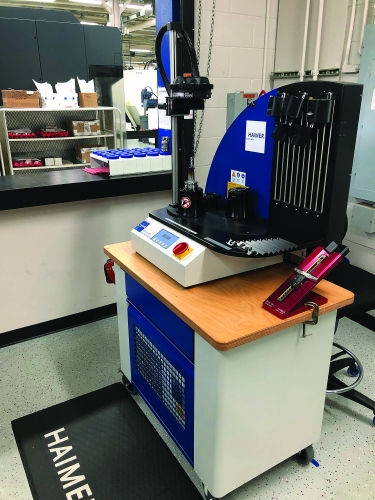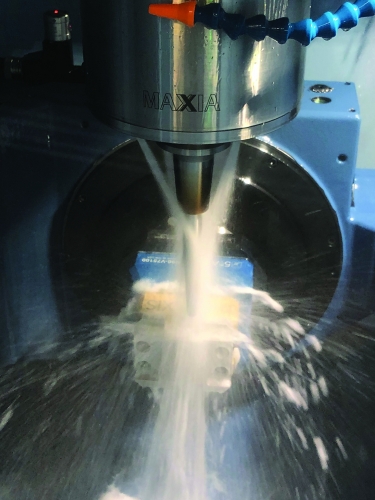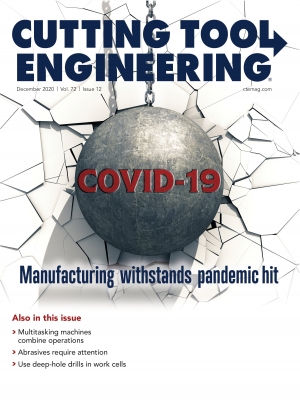A faster spindle speed increases the removal rate of a machine tool, but the cutting tool and toolholder assembly must be more balanced and rigid than what runs on a slower spindle. Raym-Co Inc. realized that after the job shop installed 25 new DMG Mori machine tools with maximum spindle speeds from 15,000 to 20,000 rpm to replace 8,000-rpm machines from the early 1990s.
“We definitely saw an increase in the ability to hold tolerances and a decrease in cycle time,” said Raym-Co Vice President Brandon Artibani, “but not as much as we had hoped.”
The Farmington, Connecticut, manufacturer was founded nearly four decades ago and operates about 60 CNC machines at its 3,437-sq.-m (37,000-sq.-ft.) facility. The shop primarily serves the medical and semiconductor industries, as well as aerospace and defense.

“We are open to anything,” Artibani said.
He said the company initially cut only plastics but eventually diversified into metals and now cuts “a ton” of aluminum, stainless steel and titanium. Plastics, such as acrylic, polycarbonate and PEEK, still account for about half of the jobs.
To further enhance the productivity and accuracy of its high-speed machining centers, Raym-Co turned to Jim Roberts, application sales engineer at Lindco Springfield in West Springfield, Massachusetts. He suggested that Raym-Co try shrink-fit toolholders from Haimer USA LLC in Villa Park, Illinois.
Raym-Co had been holding tools in collet chucks, side lock holders and milling chucks. Artibani said he was hesitant to test shrink-fit holders because he was not familiar with Haimer products and their price points were at least double what he was used to spending for holders.
“I just couldn’t justify spending more on a holder upfront,” he said. “It seemed irresponsible to spend that much just to have someone slam it into a vise.”
Nonetheless, Artibani agreed to test a few shrink-fit holders and was asked to run any job that the shop previously ran using a proven program, with the only change being the toolholder.
“Instantaneously,” he said, “there was a difference in the sound. All the cutters ran whisper quiet.”
Artibani also said tool life increased up to 300% on some tools.

Raym-Co purchased a Power Clamp Economic Plus NG shrink-fit machine with an adjustable coil and two bases. Image courtesy of Haimer USA
“After that,” he said, “we just started cranking the feed rates up until we got to where we were either snapping cutters off because the cutter couldn’t hold up or we were at the limitations of the machine. Now we incorporate that into our everyday programming, so the speeds and feeds are three times what they used to be on average.”
When endmilling aluminum, for example, Artibani said Raym-Co went from 1,270 to 1,524 mm/min. (50 to 60 ipm) to 7,620 mm/min. (300 ipm) on average and as high as 25,400 mm/min. (1,000 ipm) on some applications.
Even at elevated cutting speeds, vibration is not a concern.
“Chatter issues just don’t exist anymore,” Artibani said. “If we have chatter, it’s because the machine is shaking on the floor.”
He said he quickly learned that holding tolerances was effortless with the shrink-fit toolholders. Raym-Co holds ±0.005 mm (0.0002") on location and hole size without having to try.
To heat a holder’s bore so it expands enough to accept a tool shank and cool it so the tool is held solidly in place, Raym-Co took the recommendation of Mike O’Connor, regional sales manager at Haimer USA, and purchased a Power Clamp Economic Plus NG shrink-fit machine with an adjustable coil and two bases.

Raym-Co reports that it was able to triple or quadruple machining parameters after switching to shrink-fit toolholders. Image courtesy of Haimer USA
“You can heat one tool and move it to the side and have it in the cooling area while you heat a second tool,” Artibani said about the benefit of an additional base.
He said this capability enables Raym-Co to set up a shrink-fit holder as quickly as or quicker than assembling a collet chuck, primarily because a collet chuck must be checked for runout. Heating a holder consumes 10 seconds while cooling it takes 30 to 60 seconds.
Artibani said the company doesn’t check the runout on shrink-fit holders unless it is circular interpolating a tight-tolerance hole, which used to be bored — a slower process — before the shrink-fit holders arrived.
“It is extremely rare that the tool is running out,” he said.
Artibani said runout occurs mostly when a toolholder is not cleaned properly before accepting a tool shank. To correctly clean a holder of any carbide residue or other debris, operators clean the bore with an appropriate-size wire brush and thoroughly wipe the holder with rubbing alcohol.
“Cleaning is actually the most important part of the process,” he said.
Since implementing shrink-fit holders into its operation, Raym-Co no longer uses mill chucks but still uses collet chucks for a lot of drilling and tapping and uses side lock holders for work that doesn’t require a tight tolerance.
“I would say 80% of our tools,” Artibani said, “such as endmills, are going in a shrink-fit holder — and even a lot of our high-end drills. If we are doing deep-hole drilling, we want high precision and are putting those in shrink fits.”
He said the solid-carbide and HSS endmills that the shop applies range from 0.2 mm to 32 mm (0.008" to 1.26") in diameter, and shrink-fit holders are suitable for roughing and finishing.
Artibani estimates that the return on investment was about three weeks for the first purchase of 15 holders and the shrink-fit machine. After purchasing 30 more holders six months later, Raym-Co has added another 30 each year.
“My return on investment was probably more instant than anything else I have purchased for the company,” he said.
Contact Details
Related Glossary Terms
- centers
centers
Cone-shaped pins that support a workpiece by one or two ends during machining. The centers fit into holes drilled in the workpiece ends. Centers that turn with the workpiece are called “live” centers; those that do not are called “dead” centers.
- chatter
chatter
Condition of vibration involving the machine, workpiece and cutting tool. Once this condition arises, it is often self-sustaining until the problem is corrected. Chatter can be identified when lines or grooves appear at regular intervals in the workpiece. These lines or grooves are caused by the teeth of the cutter as they vibrate in and out of the workpiece and their spacing depends on the frequency of vibration.
- chuck
chuck
Workholding device that affixes to a mill, lathe or drill-press spindle. It holds a tool or workpiece by one end, allowing it to be rotated. May also be fitted to the machine table to hold a workpiece. Two or more adjustable jaws actually hold the tool or part. May be actuated manually, pneumatically, hydraulically or electrically. See collet.
- collet
collet
Flexible-sided device that secures a tool or workpiece. Similar in function to a chuck, but can accommodate only a narrow size range. Typically provides greater gripping force and precision than a chuck. See chuck.
- computer numerical control ( CNC)
computer numerical control ( CNC)
Microprocessor-based controller dedicated to a machine tool that permits the creation or modification of parts. Programmed numerical control activates the machine’s servos and spindle drives and controls the various machining operations. See DNC, direct numerical control; NC, numerical control.
- endmilling
endmilling
Operation in which the cutter is mounted on the machine’s spindle rather than on an arbor. Commonly associated with facing operations on a milling machine.
- feed
feed
Rate of change of position of the tool as a whole, relative to the workpiece while cutting.
- gang cutting ( milling)
gang cutting ( milling)
Machining with several cutters mounted on a single arbor, generally for simultaneous cutting.
- high-speed steels ( HSS)
high-speed steels ( HSS)
Available in two major types: tungsten high-speed steels (designated by letter T having tungsten as the principal alloying element) and molybdenum high-speed steels (designated by letter M having molybdenum as the principal alloying element). The type T high-speed steels containing cobalt have higher wear resistance and greater red (hot) hardness, withstanding cutting temperature up to 1,100º F (590º C). The type T steels are used to fabricate metalcutting tools (milling cutters, drills, reamers and taps), woodworking tools, various types of punches and dies, ball and roller bearings. The type M steels are used for cutting tools and various types of dies.
- milling
milling
Machining operation in which metal or other material is removed by applying power to a rotating cutter. In vertical milling, the cutting tool is mounted vertically on the spindle. In horizontal milling, the cutting tool is mounted horizontally, either directly on the spindle or on an arbor. Horizontal milling is further broken down into conventional milling, where the cutter rotates opposite the direction of feed, or “up” into the workpiece; and climb milling, where the cutter rotates in the direction of feed, or “down” into the workpiece. Milling operations include plane or surface milling, endmilling, facemilling, angle milling, form milling and profiling.
- milling machine ( mill)
milling machine ( mill)
Runs endmills and arbor-mounted milling cutters. Features include a head with a spindle that drives the cutters; a column, knee and table that provide motion in the three Cartesian axes; and a base that supports the components and houses the cutting-fluid pump and reservoir. The work is mounted on the table and fed into the rotating cutter or endmill to accomplish the milling steps; vertical milling machines also feed endmills into the work by means of a spindle-mounted quill. Models range from small manual machines to big bed-type and duplex mills. All take one of three basic forms: vertical, horizontal or convertible horizontal/vertical. Vertical machines may be knee-type (the table is mounted on a knee that can be elevated) or bed-type (the table is securely supported and only moves horizontally). In general, horizontal machines are bigger and more powerful, while vertical machines are lighter but more versatile and easier to set up and operate.
- sawing machine ( saw)
sawing machine ( saw)
Machine designed to use a serrated-tooth blade to cut metal or other material. Comes in a wide variety of styles but takes one of four basic forms: hacksaw (a simple, rugged machine that uses a reciprocating motion to part metal or other material); cold or circular saw (powers a circular blade that cuts structural materials); bandsaw (runs an endless band; the two basic types are cutoff and contour band machines, which cut intricate contours and shapes); and abrasive cutoff saw (similar in appearance to the cold saw, but uses an abrasive disc that rotates at high speeds rather than a blade with serrated teeth).
- shank
shank
Main body of a tool; the portion of a drill or similar end-held tool that fits into a collet, chuck or similar mounting device.
- tapping
tapping
Machining operation in which a tap, with teeth on its periphery, cuts internal threads in a predrilled hole having a smaller diameter than the tap diameter. Threads are formed by a combined rotary and axial-relative motion between tap and workpiece. See tap.
- tolerance
tolerance
Minimum and maximum amount a workpiece dimension is allowed to vary from a set standard and still be acceptable.
- toolholder
toolholder
Secures a cutting tool during a machining operation. Basic types include block, cartridge, chuck, collet, fixed, modular, quick-change and rotating.



